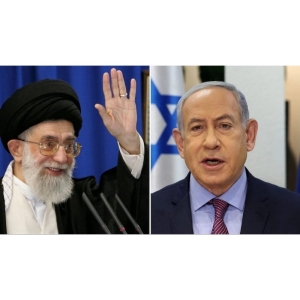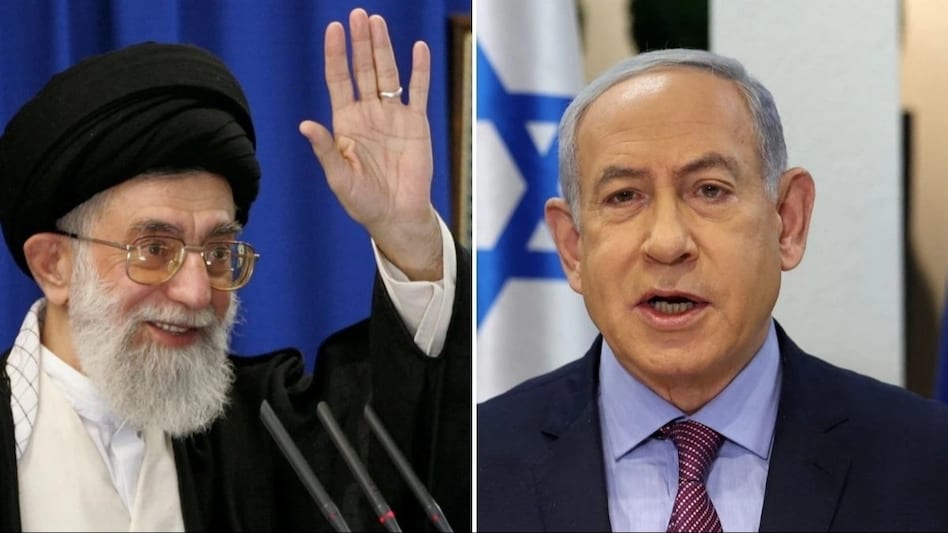
.jpg) Sacaria Joseph
Sacaria Joseph

Despite the geographical distance of approximately 1,600 kilometres and the absence of shared borders between Tehran (Iran) and Jerusalem (Israel), the simmering geopolitical tension between the two is escalating to the brink of an all-out war. This tension reflects a complex history of shifting allegiances, ideological transformations, and strategic manoeuvres that have fundamentally altered the dynamics of the Iran-Israel relationship.
Before the Iranian Revolution of 1979, Iran (formerly known as Persia) and Israel enjoyed a shared history of cordial relations. The roots of this relationship can be traced back to 539 BCE when the Achaemenid Empire, also known as the Persian Empire, conquered Babylon, where the Judean Jews lived in captivity. Subsequently, in 538 BCE, Persian King Cyrus the Great granted permission for the Jews to return to Judea, ending their Babylonian exile, thereby solidifying a cherished milestone in their intertwined history.
Israel, established as a Jewish state in immediate response to the Holocaust, was founded in 1948 to ensure the safety, security, and survival of the Jewish people. Subsequently, in 1949, Iran became one of the first Muslim-majority nations to formally recognise Israel's existence by extending diplomatic recognition to the state.
At the time of Israel's declaration of statehood in 1948, the fledgling nation faced formidable opposition from a coalition of adversaries comprising four neighbouring Arab countries (Egypt, Jordan, Syria, and Iraq), as well as several other Arab and Muslim-majority nations beyond this quartet. They vehemently opposed the concept of an independent Jewish state. In response, Israel adopted a foreign policy known as the Periphery Doctrine, which entails cultivating robust bilateral ties with non-Arab, predominantly Muslim nations located on the fringes of the Middle East. Hence, Israel forged relationships with Iran, Turkey and Ethiopia, which shared concerns about Arab nationalism and Soviet influence.
During the 1960s and 1970s, Iran and Israel found common grounds in their opposition to Arab nations, leading to their alignment as strategic partners. Together, they combated Arab nationalism and Soviet influence in the Middle East. This partnership was enhanced by extensive cooperation across military and intelligence areas.
Though Iran was a staunch ally of Israel during the reign of Mohammad Reza Shah Pahlavi, after the 1979 Revolution and the subsequent establishment of an Islamic Republic under the leadership of Ayatollah Khomeini, Iran transitioned from an ally to an ardent critic and adversary of Israel. Under the sway of Khomeini's ideology of Islamic solidarity and opposition to the perceived Western imperialism in the Middle East, Iran adopted a strong anti-Israel stance. This is evident in Iran's characterisation of Israel as the 'Little Satan,' alongside its condemnation of the United States as the 'Great Satan.'
Iran's grievances towards the United States stem from events dating back to 1953 when the United States and the United Kingdom collaborated to orchestrate a coup against Iran's democratically elected Prime Minister, Mohammad Mosaddegh. During this period, the Shah served as the head of state in his capacity as the constitutional monarch, while the Prime Minister held the position of head of the government. While the Iranian Constitution granted the Shah certain executive powers, it designated the Prime Minister to oversee the day-to-day administration and policy implementation.
In 1951, Mosaddegh decided to nationalise the Iranian oil industry in response to what he argued as an unjust arrangement between Iran and the Anglo-Iranian Oil Company (AIOC), later known as British Petroleum (BP) that held exclusive rights to explore, extract, and sell Iran's oil for 60 years. While AIOC/BP reaped substantial profits, Iran received only a nominal fixed royalty per ton of oil extracted. As Mosaddegh's decision threatened British economic interests, Britain sought the intervention of the United States to safeguard its stake in Iran. This intervention led to Mosaddegh's removal from power and the further empowerment of the Shah, who was widely seen as a supporter of Western interests.
The Shah regime was marked by severe economic inequality. A select few among the elite, including the Shah and his cohorts, controlled the nation's wealth, while the majority of Iranians endured unemployment, deprivation, and poverty. This stark contrast, coupled with the widespread belief that the Shah was a puppet of foreign powers, particularly of the United States, ignited intense anti-government sentiments within the country. Even the military, chiefly the junior officers and rank-and-file soldiers, became disillusioned with the regime as discontent spread.
During this period, under the leadership of Ayatollah Ruhollah Khomeini, Iranian religious leaders leveraged the prevailing discontent to frame the opposition against the Shah as a religious crusade against secularism and Western imperialism. They advocated for Islamic principles, including velayat-e faqih (guardianship of the jurist) within Twelver Shia Islam, as a credible alternative to the Shah's regime. This idea struck a chord with many Iranians, as they saw velayat-e faqih as a vision of equitable governance based on Islamic principles and free from Western interference. The escalating mass protests, strikes, and demonstrations ultimately led to the overthrow of the Shah's government in 1979 and the establishment of an Islamic Republic.
The nascent Islamic Republic of Iran embraced a profound ideological transformation, reshaping its domestic and foreign policies. Enshrined in its 1979 constitution, Iran assumed the responsibility to export its revolution in solidarity with the oppressed globally. It regards Israel as an illegitimate occupier of Muslim lands and a symbol of Western imperialism. Consequently, Iran views the existence of Israel as illegitimate and advocates for its eradication. Ali Khamenei has consistently likened Israel to a "cancerous tumour" destined to be removed. Moreover, he affirms that beyond political strategy, the Palestinian cause, for Iran, has evolved into "an issue of beliefs, an issue of the heart and an issue of faith." This assertion underscores Iran's steadfast support for Palestinian aspirations in the post-revolutionary era.
As a strategy for furthering the causes of the Palestinians, Iran began to intervene in the Israeli-Palestinian conflict through its support of guerilla groups fighting against Israel, such as Hamas and Palestinian Islamic Jihad (PIJ) in Palestine and Hezbollah in Lebanon. By backing Palestinian factions opposed to peace negotiations with Israel, Iran kept obstructing dialogue and negotiations between Israelis and Palestinians. Iran is determined to present the Israeli-Palestinian conflict as a broader confrontation between Judaism and Islam rather than a regional dispute. By doing so, Iran seeks to expand the scope of the conflict beyond national borders and frame it as a clash of civilisations.
Against the backdrop of the thoroughly altered Israeli-Iranian relations, Israel has adopted a new foreign policy known as the reverse Periphery Doctrine that prioritises strong bilateral relationships with key Arab nations that harbour hostility towards Iran.
Israel is widely suspected of possessing nuclear weapons; nevertheless, it maintains an official policy of deliberate ambiguity regarding its nuclear capabilities. This ambiguity sparks concerns among both regional and international communities regarding stability and security in the Middle East. In contrast, Iran asserts that it does not possess nuclear weapons and denies any intention to weaponise its civilian nuclear program or become a nuclear-armed state. Nevertheless, apprehensions persist regarding the potential for Iran to acquire nuclear weapons, a scenario that could precipitate a substantial power shift in the region and lead to Iran adopting a more aggressive stance towards Israel.
In the 1950s, the United States assisted Iran with its peaceful atomic program, intended for purposes like electricity generation and medical research. However, since the Iranian Revolution, there has been suspicion that Iran may have shifted its focus towards developing nuclear weapons. Iran's uranium enrichment, construction of nuclear facilities, and lack of transparency regarding its nuclear activities have prompted international scrutiny and escalated its tensions with the United States, European nations, and Israel.
Over the years, the international community has made various diplomatic efforts to address Iran's nuclear program. These efforts have included negotiations, sanctions, and the Joint Comprehensive Plan of Action (JCPOA), also known as the Iran Nuclear Deal, reached in 2015 between Iran and the P5+1 countries (five permanent members of the United Nations Security Council and Germany). The JCPOA was designed to limit Iran's nuclear activities in exchange for sanctions relief. However, in 2018, the United States withdrew from the agreement unilaterally, citing concerns about Iran's compliance and wanting to renegotiate a stricter deal.
The 'Axis of Resistance' (a loose coalition that comprises various anti-Western and anti-Israeli entities such as Iran, Syria, Hezbollah in Lebanon, and certain Palestinian factions like Hamas and Islamic Jihad, as well as Shiite militias in Iraq and Yemen) poses a significant security and existential threat to Israel. Led by Iran, this coalition opposes Israel's occupation of Palestinian territories and advocates for Palestinian self-determination. The Axis of Resistance seeks to challenge Israel's regional presence and counter Western influence, particularly that of the United States, employing militant tactics and strategies to undermine Israel's security and territorial integrity.
Israel has been conducting airstrikes in Syria for more than a decade, often citing the necessity to counter Iranian influence and the presence of Hezbollah in the region. Iran has actively supported the Assad regime in Syria and sponsored various proxy groups, notably Hezbollah, aiming to extend its influence and establish a stronghold in Syria. From Israel's perspective, the proximity of Iranian forces and Hezbollah militants to its northern border presents a significant security challenge. Consequently, Israel has periodically carried out airstrikes targeting Iranian and Hezbollah assets in Syria to address these security concerns. However, such actions also risk escalating regional tensions and provoking retaliatory measures from Iran or its proxies.
Israel's airstrikes on the Iranian consulate in Damascus on 5 April 2024 that resulted in the deaths of seven officers of the Islamic Revolutionary Guard Corps (IRGC), including the Quds Force's General Mohammad Reza Zahedi, were bound to provoke retaliation. In response, on 13 April, Iran launched over 300 drones and missiles towards Israel, the majority of which were intercepted either outside Israeli airspace or over the country itself. On 18 April, Israel retaliated with airstrikes in the Iranian cities of Isfahan and Tabriz. The unfolding of events between the two nations remains uncertain, with time being the ultimate arbiter.
The intricate web of Iranian-Israeli relations spun across centuries of history, geopolitics, and shifting ideologies paints a picture of cooperation mingled with conflict, driven by shared interests and opposing viewpoints. With recent tensions escalating between the two, the future of their relationship appears increasingly uncertain, casting shadows over regional stability. Owing to their divergent interests and ideologies, the prospect of peace remains distant but not impossible. Let us hope that both sides can navigate these complexities without plunging into full-scale conflict, preserving the fragile balance in the region.